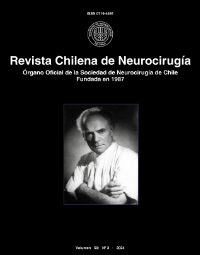Gradenigo's syndrome with pontocerebellar abscess: A literature review regarding a case
##plugins.themes.bootstrap3.article.main##
Abstract
The syndrome corresponds to a rare and complex complication of an otic infectious process, generating secondary mastoiditis-petrositis, with involvement of adjacent neurovascular structures. Acute otitis media (AOM) being a common bacterial condition in pediatrics, its complications are rare due to the advent of antibiotic therapy; therefore, the description of Gradenigo Syndrome has few bibliographic reviews. The syndrome, described by Giuseppe Gradenigo, is characterized by a clinical triad consisting of signs of AOM, facial pain and ophthalmoparesis, and its diagnosis includes neuroimaging. His therapy, which includes antibiotic, corticosteroid, and eventually surgical management, has transitioned from radical surgery to conservative medical management. The case of a pediatric patient managed in a Regional Hospital of Chile is presented.
##plugins.themes.bootstrap3.article.details##
Gradenigo, petrositis, cerebral abscess, retrosigmoid approach
1. Gradenigo G. Sulla leptomeningite circonscritta e sulla parallisi dell'abducente di origine otitica. G Accad Med Torino 1904;10:59-84.
2. Gradenigo G. On paralysis of the nervus abducens in otitis. Arch Ohrenheilk 1907; 74:149-58. https://doi.org/10.1007/BF01930369
3. Methol, Guillermina, García, Loreley, & Giachetto, Gustavo. (2016). Síndrome de Gradenigo: una complicación poco frecuen¬te de la otitis media aguda. Archivos de Pediatría del Uruguay, 87(1), 44-48.
4. Guedes, Verónica. y cols. (2010). Síndrome de Gradenigo: comunicación de un caso. Archivos argentinos de pediatría, 108(3), e74-e75.
5. Catarina, Mendes, Garrido, Cristina, Guedes, Margarida, & Mar¬ques, Laura. (2014). Gradenigo syndrome: an unexpected otitis complication. Nascer e Crescer, 23(1), 25-28.
6. Choi, K. Y., & Park, S. K. (2014). Petrositis With Bilateral Abducens Nerve Palsies complicated by Acute Otitis Media. Clinical and experimental otorhinolaryngology, 7(1), 59-62. https://doi.org/10.3342/ceo.2014.7.1.59
7. Motamed, M., & Kalan, A. (2000). Gradenigo's syndrome. Postgraduate medical journal, 76(899), 559-560. https://doi.org/10.1136/pmj.76.899.559
8. Chan KC, Chen SL. (2023). Diplopia in a Child: Gradenigo Syndrome Is an Unforgettable Disease. Ear Nose Throat J. Feb;102(2):NP53-NP55. https://doi.org/10.1177/0145561321989459
9. Rossi N, Swonke ML, Reichert L, Young D. (2019). Gradenigo's syndrome in a four-year-old patient: a rare diagnosis in the modern antibiotic era. J Laryngol Otol. Jun;133(6):535-537. https://doi.org/10.1017/S0022215119001026
10. Branco T, Marques C, Santos VC, Lopes JM. (2023). Gradenigo's Syndrome With Septic Lateral Sinus Thrombosis. Cureus. Feb 9;15(2):e34797. https://doi.org/10.7759/cureus.34797
11. Guarnizo, A., & Rugilo, C. (2023). Gradenigo's syndrome associated to internal carotid artery vasculitis. Acta neurologica Belgica. Advance online publication. https://doi.org/10.1007/s13760-023-02408-6
12. Humayun, H. N., Akhtar, S., & Ahmed, S. (2011). Gradenigo's syndrome-surgical management in a child. JPMA. The Journal of the Pakistan Medical Association, 61(4), 393-394.
13. Cabrera-Maqueda, J. M., Fuentes Rumí, L., Valero López, G., Baidez Guerrero, A. E., García Molina, E., Díaz Pérez, J., & García-Vázquez, E. (2018). Difusión de los antibióticos en el sistema nervioso central [Antibiotic diffusion to central nervous system]. Revista espanola de quimioterapia : publicacion oficial de la Sociedad Espanola de Quimioterapia, 31(1), 1-12.

This work is licensed under a Creative Commons Attribution-NonCommercial 4.0 International License.








